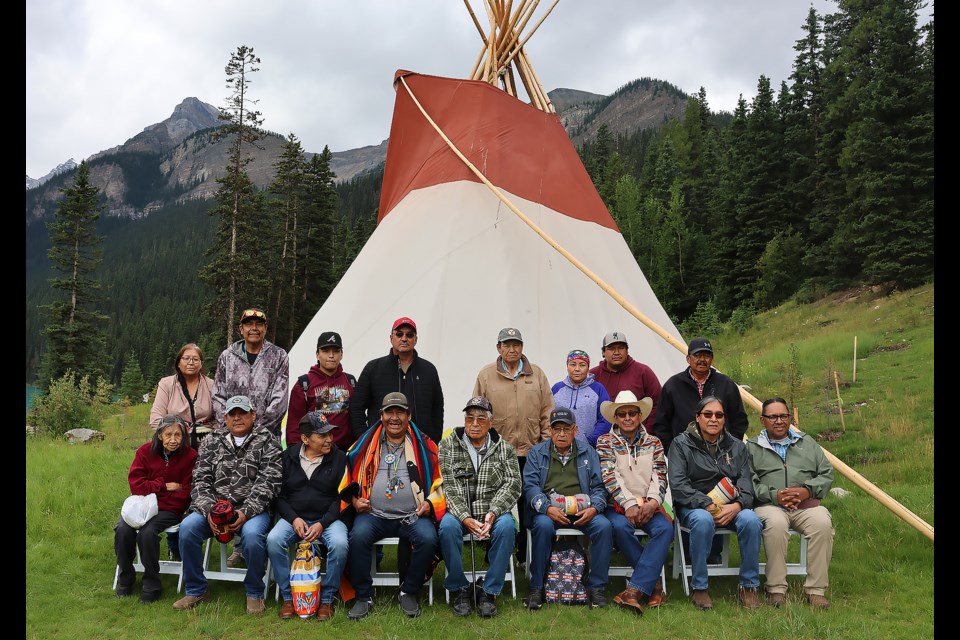BANFF – Îyârhe (Stoney) Nakoda First Nation is working with Parks Canada on a new pilot project that reconnects Indigenous peoples to sacred places in Banff National Park, opening the door to Indigenous tourism where visitors can gain a deeper understanding of the land through Indigenous-led experiences.
Through the national park Indigenous advisory circle, which includes representation from eight Nations, the Lake Louise area is being used as a model to support Indigenous-led cultural and interpretation activities.
“The main point of all this is that the Stoney people have a cultural, spiritual connection to both of those places [Moraine Lake and Lake Louise], and that’s why we’ve been conducting ceremonies,” said Bill Snow, director of consultation with Stoney Tribal Administration.
“What comes second is the tourism aspect. That’s not the primary reason we’re up there. The primary reason is to reconnect to that landscape and to acknowledge the spirituality of those places.”
In 2023, the Indigenous advisory circle recommended adding Indigenous cultural content and perspectives to interpretive information in the Lake Louise area.
“The lands and waters of Lake Louise are sacred, culturally important and hold a significant connection to each Nation,” said Annie MacNeil, acting public relations and communications officer for Lake Louise, Yoho and Kootenay field unit.
“As the original stewards of this land, the cultures and identities of Indigenous peoples, and honouring connections to place, is an important element for actions and outcomes related to reconciliation.”
To the Stoneys, Lake Louise is known as Horâ Juthin Îmne, meaning lake of the little fishes.
Along with Moraine Lake and other now popular tourist destinations in Banff National Park, the area has long held spiritual importance to its original Indigenous caretakers.
Moraine Lake is known to Îyârhe Nakoda First Nation as a place of healing.
“Our people used to come up here and do healing and it’s also kind of like a medicine chest here,” said Barry Wesley, a traditional knowledge keeper and consultation officer for Goodstoney First Nation. “Our people would come and harvest medicines here and at the same time, they come and wash up. You cleanse yourself in the water, not unlike the way you do with a smudge.
“We clean ourselves like that to wash away any kind of illness and to get rid of negative energy. Our ancestors have been doing that long before this place became a tourist destination.”
Îyârhe Nakoda First Nation, in coordination with Parks Canada, started practicing ceremonies at Lake Louise in 2020. In the last year, the Nation extended this to Moraine Lake. On Sunday (Aug. 25), a pipe ceremony was held there while pow wow dancing and other activities were held at Lake Louise. A ceremony was also held at Lake Louise Saturday (Aug. 24).
While Moraine Lake is not included in the pilot program, Parks Canada has so far this year dedicated roughly $260,000 of funding for Indigenous-led interpretation activities at Lake Louise. The funding supports the eight Nations in the Indigenous advisory circle for Banff National Park, helping to share their languages, cultures, perspectives, and stories.
Right now, Wesley said the circle is “just a circle; a voice.” The goal is co-management of the national park.
“Right now, we’re looking at tourism. We’re not really part of any of the tourism and we need to be part of that somehow. These operations are happening right in our home, so we have every right to be part of what goes on.”
Most of the millions of visitors that come to Banff National Park are missing out on the Indigenous experience, Snow added.
The pow wow dancing at Lake Louise on Sunday signifies a reconnection to place and traditions but was also part of a public demonstration, explaining what those dances are and what they mean to the crowds of people who visited the site.
“We’re just starting that work, so there’s going to be bends and curves in the road. It’s going to take time to work through all the issues but I think if there’s anything I could add, it’s that there’s a lot of possibilities we’re not practising right now, and we’re being driven by the ceremonies,” said Snow.
“It’s taken four years now to get to this point for Lake Louise and we’re kind of working our way through the same process for Moraine Lake,” he added.
“If we’re guided in the right way by the ceremonies, then I think we’ll get to where we’re going. But right now, there’s virtually no Indigenous content, by and large, for tourism experiences. That’s ultimately what we’re trying to change, but we have to do it gradually and we have to do it in a meaningful way.”
The Local Journalism Initiative is funded by the Government of Canada. The position covers Îyârhe (Stoney) Nakoda First Nation and Kananaskis Country.




